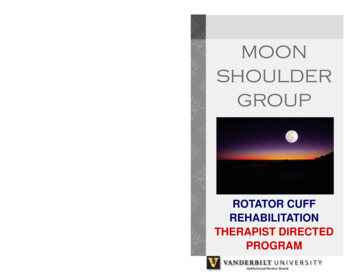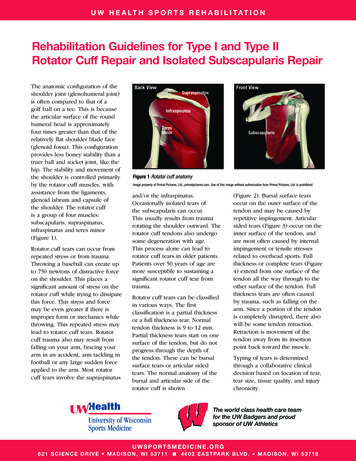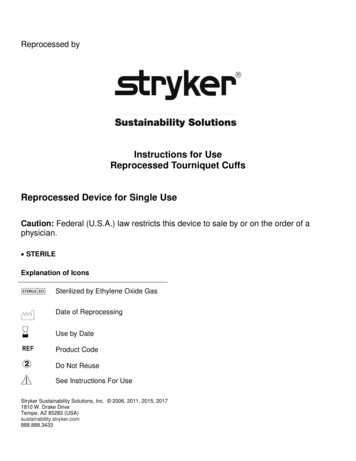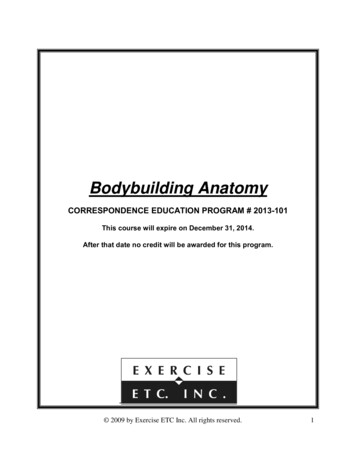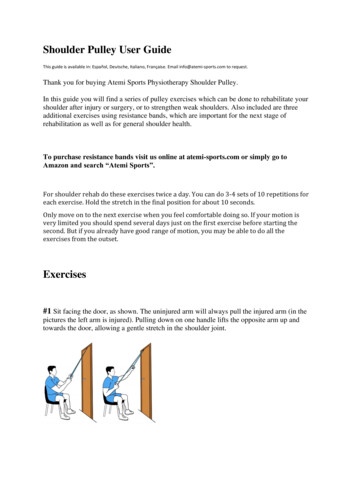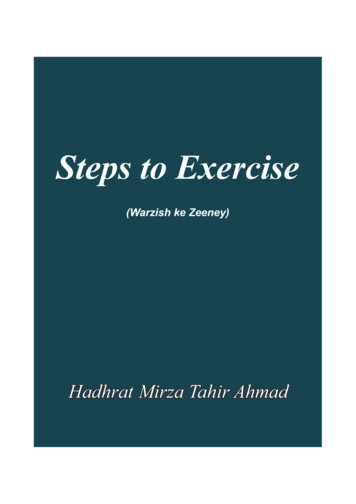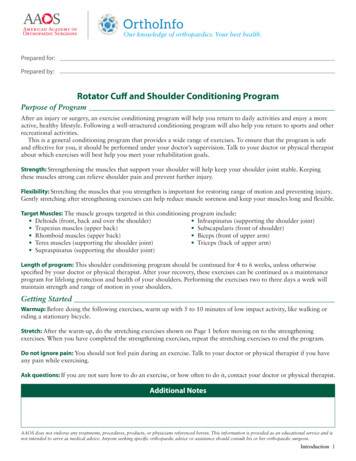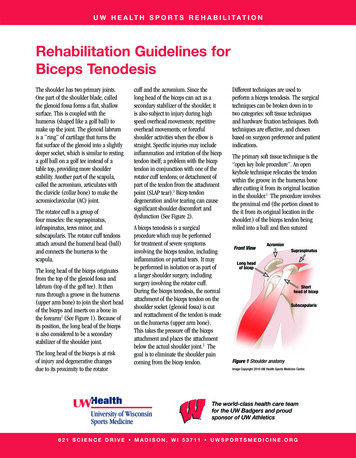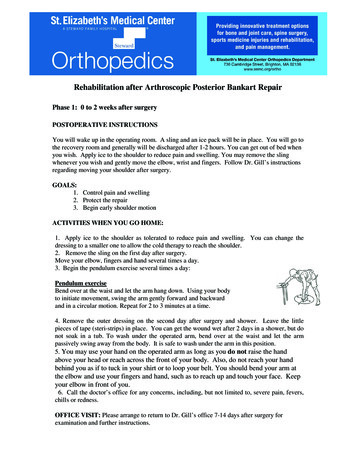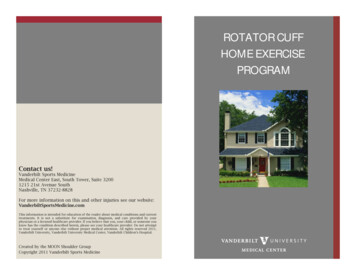
Transcription
ROTATOR CUFFHOME EXERCISEPROGRAMContact us!Vanderbilt Sports MedicineMedical Center East, South Tower, Suite 32001215 21st Avenue SouthNashville, TN 37232-8828For more information on this and other injuries see our website:VanderbiltSportsMedicine.comThis information is intended for education of the reader about medical conditions and currenttreatments. It is not a substitute for examination, diagnosis, and care provided by yourphysician or a licensed healthcare provider. If you believe that you, your child, or someone youknow has the condition described herein, please see your healthcare provider. Do not attemptto treat yourself or anyone else without proper medical attention. All rights reserved 2011,Vanderbilt University, Vanderbilt University Medical Center, Vanderbilt Children’s Hospital.Created by the MOON Shoulder GroupCopyright 2011 Vanderbilt Sports Medicine
IntroductionThe MOON Shoulder group is a Multi-centerOrthopaedic Outcomes Network. In other words, itis a group of doctors from around the countryworking together to do research so they can givepatients with shoulder problems the best possiblecare.Your doctor, athletic trainer or physical therapistcan help guide you through this program which isbroken up into three parts:Range of Motion— you should do this every day tohelp get your motion back.Flexibility— you should do this every day to helpstretch tight tissues.Strengthening– you should do this 3 or 4 days eachweek to help get your strength back.For most of the exercises you will do a certainnumber of repetitions (or reps) and a certainnumber of sets. Example: 3 sets / 10 repsSet 1: Do the exercise 10 times and then rest for afew seconds,Set 2: Do the exercise 10 times and then rest for afew seconds,Set 3: Do the exercise 10 times and then rest for afew seconds. Then move onto the next exercise.152
Please do not add, skip or alter any of theexercises without talking to your doctorfirst.If you are unable to view the video online, ask yournurse for a DVD.The physical therapy program used in this studymay be downloaded at the following sites:Patient Home Physical Therapy dfTherapist Directed Physical TherapyRehabilitation nt Home Physical Therapy RehabilitationVideo:DVDAt the back of this booklet you will also find aDVD. The DVD shows you how to do all of theexercises in this booklet. Some points toremember:1. The Range of Motion and Flexibility exercisescan be done every day, while the strengtheningexercises should be done 3 or 4 times perweek.2. With the Range of Motion exercises, it may beeasier and less painful to start while lying onyour back. When that becomes comfortable,you can do the exercises standing.3. With strengthening, if you have moderate orsevere pain with any of the exercises, youshould decrease the resistance, decrease theamount of times you do the exercise, or skipthe exercise until you can do it without pain.If you have any questions after reading thebooklet or watching the DVD, talk to yourdoctor, physical therapist, or athletic cs/25982143
The red arrows point to the injured shoulder inthe pictures where it may not be clear.Range of Motion ExercisesDo these every day1. Pendulum exercises.Jackins’ ExercisesIf you have a hard time raising your arm, youshould try these Jackins’ exercises.Do 3 sets / 10 reps. for each exercise.Move your body and let the movement of yourbody move your shoulder. Example: Rest yourgood hand on a table and bend over a little at yourwaist. Make circles with your hips/body whichwill cause your injured arm to make circles.Repeat this by moving your hips/body indifferent directions. Do not use your shouldermuscles. Do each motion 20 times.Let the injured arm hang overthe side of the table. Make 20small circles in one directionand then 20 small circles inthe other direction. Makeforward and backwardmotions 20 times and thenside to side motions 20 times.Figure 1Figure 2Figure 3Begin by lying flat on your back (1). While lyingon your back lift your injured arm over your head,using your good arm to help. Once this getseasier, try raising the injured arm by itself. Oncethis gets easier, try raising the injured arm with asmall weight in your hand.2. Posture exercises.These exercises should be done within the painfree range. In other words you should not haveany pain while doing these exercises.Do this exercise 20 times.Put your hands on your hips,lean back and hold for 20seconds.4Once this gets easier raise your back by resting onpillows or sitting in a recliner (2) and start thewhole process over. Keep raising your back andstarting the process over again until you arestanding straight up.Again, if you have any questions after readingthis booklet or watching the DVD, talk to yourdoctor, physical therapist, or athletic trainer.13
8. Push Up Plus:3. Active assisted range of motion.Do 3 sets / 10 reps.Use a cane/broomstick/pulley system so the goodarm moves the injured arm.Do 3 sets / 10 reps for each exerciseFigure 1Do a pushup (either on your hands or forearms)and then really push to bring your spine to theceiling. Kneeling on the floor, place your hands orforearms on the floor. Start by doing a push-up,then round your back. Really push to try to touchyour spine to the ceiling.9. Posterior Deltoid:Do 3 sets / 10 reps.Figure 2Figure 3Lying on your back, hold the cane with bothhands. Raise your arms using the good arm tohelp guide the injured arm (Figure1). Next usethe good arm to move the injured arm to the side(Figure 2). Lastly, use the good arm to move theinjured arm up to the side and up (Figure 3) Youmay start to use your injured arm more as it startsto feel more comfortable. Again as you start tofeel more comfortable you can also do thesestanding up.4. Active training of the scapula muscles.Two exercises are shoulder shrugs and pinchingyour shoulder blades.Do 3 sets/10 reps for each exercise.Lying on your stomach hang your arm over theside of the bed or couch. While holding a weight,bring the arm out to the side and hold for 20seconds.12ShoulderShrugs:Pullshouldersup andback andhold.Pinch theback of theshoulderbladestogetherusing goodposture.5
5. Active range of motion. Raise your injured5. Chair Press:arm while looking at yourself in the mirror—besure not to hike or raise your shoulder! You canplace your hand (from your good arm) on top ofyour injured shoulder to make sure the muscles arerelaxed.Do 3 sets / 10 reps.Do 3 sets / 10 reps.In front of a mirror practiceraising your arm in front ofyour body without shruggingyour shoulder.While seated put your hands onthe seat or on the arm rests.Then press down with your arms,lifting your body off chair. Try tokeep your back straight.6. Shrugs: Like the shoulder shrugs (page 5),except this time you use weights.Do 3 sets / 10 reps.FlexibilityDo these every dayStand with weights in hands.Roll shoulders back and hold.Hold each stretch for 30 seconds and rest for about 10seconds in between. Repeat five times per day.1. Door Stretch.AB7. Press Up:Do 3 sets / 10 reps.Place your hands or forearms at shoulder level oneach side of a door frame or in a corner of a room(A). Lean forward into door or corner and hold.Next place your hands or forearms over your head oneach side of the door, lean forward and hold (B).6Lie on back, elbow lockedstraight, arms stretched uptowards the ceiling withweights in hands. Move/Push arms up towards theceiling as far as possible.11
Postural / Periscapular Muscle Strengthening2. Sleeper Stretch.3. Rows: Do 3 sets / 10 reps.While sitting or standing,bring arms up to shoulderheight and bend yourelbows. Grab the elasticbands with both hands and tryto pull the elastic cords back,pinching your shoulder bladesbehind you.ORAn upright row can be done with a hand weight.(If you do not have hand weights, use a can of soup).Do one arm at a time. Whilestanding lean over a table. Bendat waist. With your elbow bentraise your arm towards theceiling, pulling your shoulderblade back.On a flat surface lie on your side with yourinjured shoulder down. Raise your arm toshoulder height and then bend your elbow. Useyour good arm to push your forearm (of theinjured shoulder) down towards the floor or bed.3. Golfer Stretch.4. Low Trapezius Exercise:Do 3 sets / 10 reps.Stand straight up. Grab the elasticbands with both hands. Keepelbows straight and pull your armsbackwards, trying to reach behindyou.10Bring the injured arm across in front of body.Hold elbow with other arm (see picture).Gently pull your forearm (of your good arm )towards your chest/face which will pull theinjured arm across chest until a stretch is felt inthe back of shoulder.7
4. Towel Stretch. Place the hand of yourgood arm behind your neck and the hand of theinjured shoulder by your back pocket. Grab atowel with both hands. Use the good arm to pullupward, bringing the injured arm up the back.Hold your good arm over shoulderwith towel as shown. Grasp thetowel with your injured arm. Slowlypull upward with your good armuntil a gentle stretch is felt.2. Internal / External Rotation against resistance.Stand up when using elastic bands or lie on side touse hand weights. If you are using elastic bandsplease tie them to a doorknob in order to secure them.Keep the arm against the body. Internally rotateagainst resistance for internal rotation. Externallyrotate against resistance for external rotation.Do 3 sets / 10 reps.Secure elastic at waist level.Hold elbow at 90 degrees witharm at side. Pull hand away frombody as shown.Strengthening Do these 3 to 4 times per weekRepetitions and/or resistance can be increasedas tolerated.Be sure to use good form.If you have moderate or severe discomfortreduce the level of resistance or decrease therange of the exercise until it is comfortable.Rotator Cuff Strengthening1. Isometrics against a wall.Do 3 sets / 10 reps.ABPress the outside of yourforearm against a wall (A)for 20 seconds. Relax.Next press the inside ofyour forearm against a wall(B) for 20 seconds. Relax.8Secure elastic at waist level.Hold elbow at 90 degrees arm atside. Pull hand across body asshown.ORLie on injured side, elbow bentat 90 degrees, arm at side.With or without weight, pullhand towards your belly.Lie on side, injured side up.Arm at side, elbow bent, withor without weight, move handaway from your belly.9
towards your chest/face which will pull the injured arm across chest until a stretch is felt in the back of shoulder. 8 4. Towel Stretch. Place the hand of your good arm behind your neck and the hand of the injured shoulder by your back pocket. Grab a towel with both hands. Use the good arm to pull
